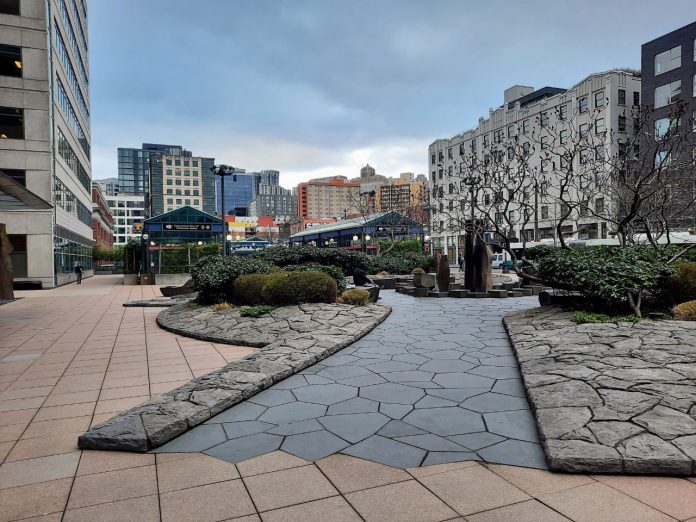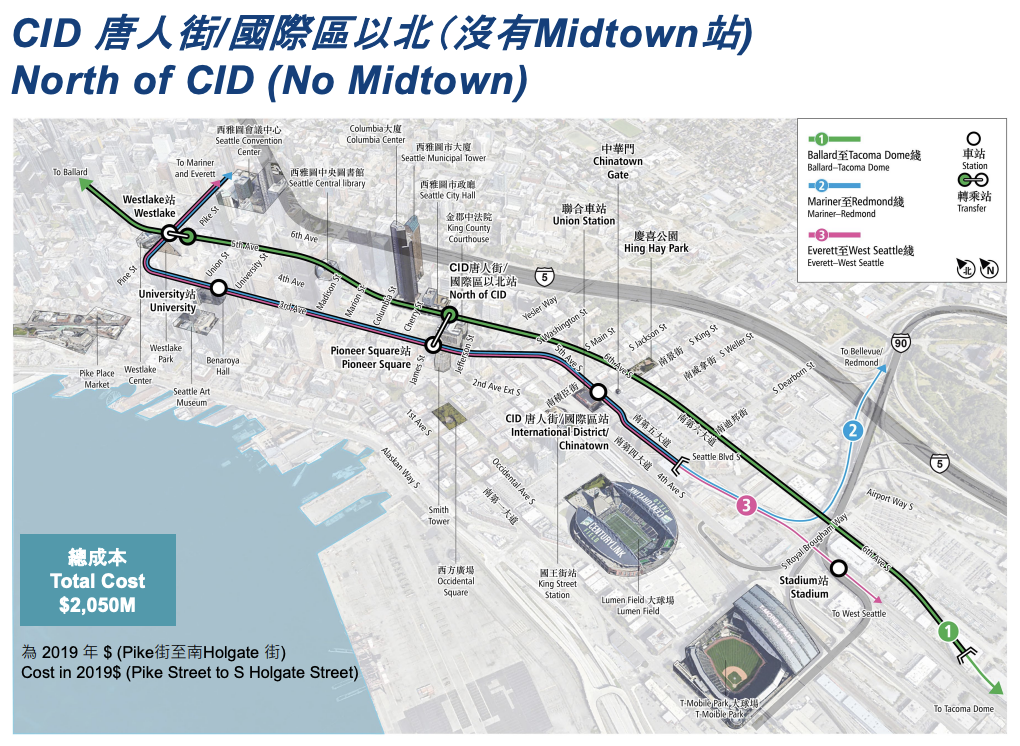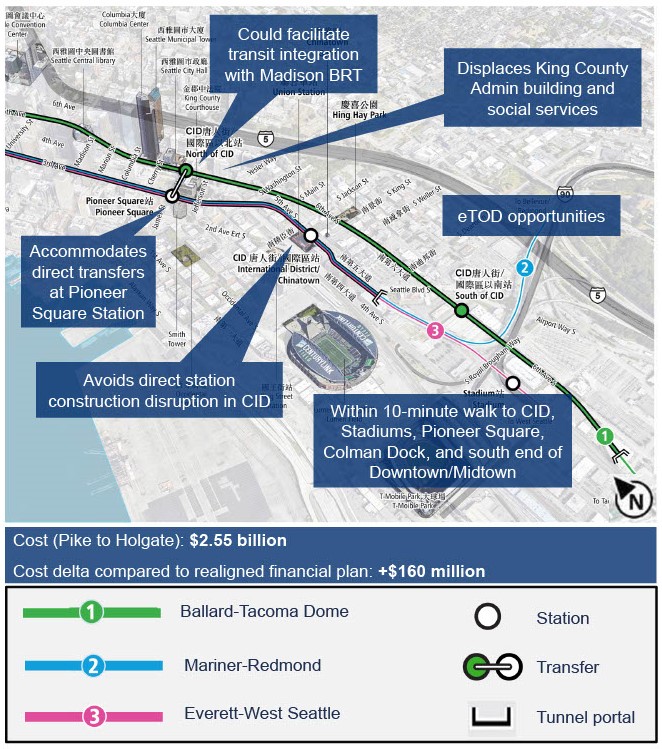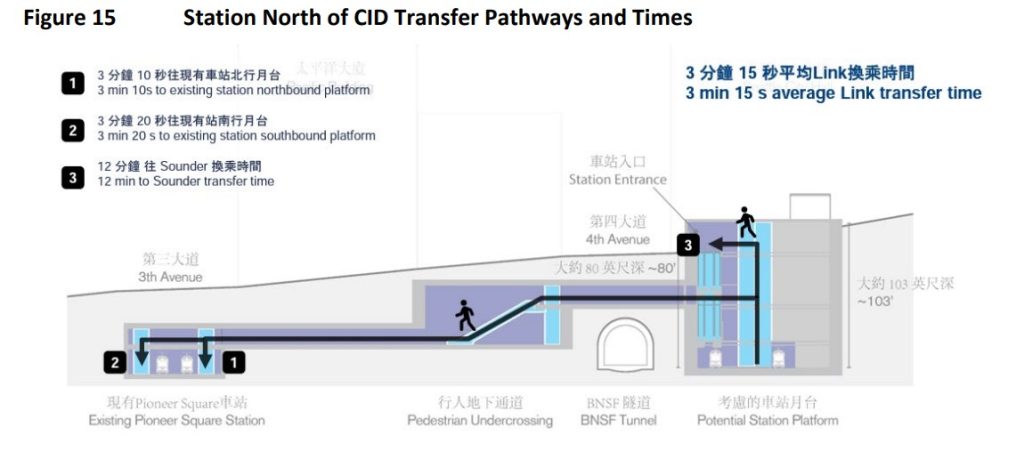
Sound Transit boardmember talks lessening third-party funding demands, honing decision-making culture, and kicking the can.
The Sound Transit Board of Directors will determine Seattle’s transit future on March 23. That decision, especially the late-breaking alternatives hugely factoring into it, have flown under the radar. The route through Downtown Seattle has been particularly troublesome, with some residents of the Chinatown-International District (CID) seeking to reject a new station in their neighborhood altogether to avoid a decade of construction impacts.
Other residents under the banner of the Move Forward on 4th Coalition have backed a 4th Avenue alternative adjoining the existing CID Station and providing a world-class transit hub integrating Union Station with intercity rail, commuter rail, bus, and streetcar service. The coalition includes the Chong Wa Benevolent Association, Friends of Chinatown Seattle, Historic South Downtown, Alliance for Pioneer Square, SCIDpda, Seattle Subway, and The Urbanist, and has the backing of more than 3,500 signatories in an online petition.
However, the agency has said the 4th Avenue alternative would require an additional $700 million in third-party funding and take longer to build. A competing coalition of residents, small businesses, and nonprofits is rallying support against 4th.
Board Chair and King County Executive Dow Constantine has thrown his weight behind a last-minute “North of CID” option that skips both the CID and Midtown stations. Constantine’s proposal seems to have catapulted not just into contention, but into the inside track to be selected by the board as the preferred alternative of the Draft Environmental Impact Statement (DEIS). Doing so would require extending the DEIS study to complete the additional work on the new option, delaying the Final EIS.
Constantine and Seattle Mayor Bruce Harrell say they have lined up $400 million in County and City support for the new option, which could further sway colleagues. The details of this funding package have not yet been released, but are pledged by the time of the vote.
King County Councilmember Claudia Balducci, who chairs the Sound Transit Board’s System Expansion Committee, has not yet embraced the new option. She signaled openness to revisiting the discussion about third-party funding since the baseline scenario involved a 5th Avenue CID station that has been ruled out and deemed “culturally infeasible” with no visible support on the board or in the community.
“There has got to be a way to afford a good transit option,” Balducci said in an interview with The Urbanist. “In my view, the 4th Avenue station is the best remaining option, but there are challenges with it. There’s risk to construction. There’s high risk of it being a very lengthy construction. That road is a lynchpin arterial into the largest downtown in the state. There’s no blithe answer here.”
While skipping the CID and Midtown appears to simplify project financing, it does not simplify future transit trips. In fact, it greatly complicates the usability and efficiency of the system for transit riders. Agency analysis of the new option’s impact to riders has been incomplete, but The Urbanist’s Stephen Fesler laid out the significant rider delays and awkward transfers this alignment would force.

Selecting Constantine’s “North of CID” option would mean the future Ballard-to-Tacoma light rail line not would stop in the CID or Midtown. Once the line is extended and routed through the new downtown tunnel, Beacon Hill and the Rainier Valley would no longer have a direct light rail connection to the CID that they currently enjoy. The Eastside would also have a far worse transfer to head anywhere south of Pioneer Square and vice versa. Ballard Link’s connections to Amtrak, Sounder, and the First Hill Streetcar would all be subpar in perpetuity, degrading service for hundreds of thousands of future riders. Losing Midtown alone wipes out 15,500 daily riders expected at the station, which provided walking connections into First Hill plus a convenient bus transfer with the Madison RapidRide G Line.
At the March 9th System Expansion Committee meeting, Chair Balducci raised the possibility of adjusting third-party funding requirements that are limiting options through Downtown Seattle. She reiterated that concept on Friday.
“We should really reconsider using the 5th Avenue as the baseline against which third-party funding is measured,” Balducci said. “If the station location were geologically impossible to build because of steep slopes…we wouldn’t use that as the financial baseline, because we’re not going to build it.”
Raising $700 million beyond the Sound Transit 3 plan is not something any city or county has had to do to get their preferred light rail alignment. Lessening the requirement might allow a better option to emerge.
“That takes some of the financial pressure off the City [of Seattle],” Balducci continued. “The City is like, ‘where are we going to pony up with all this money?’ Why should they have to pony up all this extra money? I’m not a Seattle person, and I don’t think they should have to, because there’s an option that nobody wants to build that’s cheaper.”
Whether enough of Balducci’s colleagues agree with that assessment to change the baseline remains to be seen.
The CID is unique, historic, and a “regional cultural treasure,” Balducci said. She added that, setting aside community impact, the 5th Avenue option was the best option in terms of transit connectivity, cost, and speed of delivery. However, the impact to CID was a huge risk and the board deemed the option unacceptable and eliminated it from consideration. Nonetheless, the lower baseline cost estimates of 5th Avenue remain. And that complexity is why the agency is in such a predicament now.

The CID Coalition and Puget Sound Sage remain staunchly opposed to the 4th Avenue alternative and have backed an alternative pairing station dubbed North of CID and South of CID. They argue this is the only option to ensure the survival of Chinatown. South of CID would entail a station along 6th Avenue a few blocks south of the Uwajimaya Asian Market. Construction impacts of the option have not been studied in nearly as much detail as the options that were already in the DEIS. Suffice to say, bookending the CID with construction projects on either edge could still entail significant traffic impacts.
Will advice from outside experts factor into decision?
The board’s big decision happens to come just weeks after receiving a 60-page report it commissioned from its Technical Advisory Board (TAG) seeking to refine agency processes and control capital costs. With her 2021 hybrid realignment plan, Balducci stressed similar improvements to lessen project delays by controlling costs and identifying additional funding. The Urbanist broke down the TAG report in detail yesterday, but big takeaways from these outside transit experts included focusing on transit outcomes and empowering the agency to make more decisions without micromanagement from the board. On the flip side, rebuilding and strengthening trust between the board and agency would also encourage staff to quickly raise serious issues to the board when they do arise.
While several boardmembers said they would take the recommendations seriously and embrace that call for process improvement, it’s not clear if they will approach Ballard Link decisions any differently than they have in the past. It’s easy to say boardmembers should leave their other allegiances behind and become like nonprofit boardmembers focused on the achieving the mission and best outcomes of the collective organization. In reality, boardmembers have to balance their duties as elected officials with those as Sound Transit boardmembers.
“It’s not realistic to expect that this will result in the board handing over all responsibility for siting over to the staff and that their technical recommendation is what will happen and we will not respond to community outbursts,” Balducci said. “We’re there to respond to the community and represent the community. It would be giving up our job to not respond to the community.”
Nonetheless, a clearer decision-making process may allow Sound Transit to arrive at decisions quicker, which was another big recommendation from the TAG report.
“We can be much clearer about our policies, our priorities,” Balducci said. “All other things being equal, we should pick the alignment and location that served the best transit purpose, which is to say ridership, convenience of transit, all of the things — you could list them out.”

With the board making its priorities clear, the staff would have firmer footing to base its work and be empowered to come up with their singular recommendation. Then it would be incumbent on the board to go with the agency recommendation more often.
“We have to build a culture of we’re going to do that absent fatal flaws,” Balducci said. “Instead of all that work is just prologue to the real discussion before the real work of the DEIS and then we do it all over again after the DEIS.”
No more kicking the can down road
While getting the decision right is crucial, time is also of the essence. The first draft of the West Seattle and Ballard Link DEIS has already been out for more than a year, and the board has selected preferred alternatives for most stations, except for the three stations it couldn’t come to a consensus around: the CID, Denny, and Uptown.
“We have to start thinking like this: How do we make a good option buildable? How do we make it affordable? And we’ve got two whole weeks to do it,” Balducci said with a chuckle.
Balducci said she expects a decision on March 23 rather than the board opting continuing to delay the decision on a preferred alternative for the Ballard Link DEIS.
“There’s a lot of desire to not continue to kick this can down the road,” Balducci said.
Provide feedback to the Sound Transit Board at meetingcomments@soundtransit.org before their March 23rd meeting. To speak in-person at the 1:30pm meeting at Union Station, sign up at least 30 minutes before the meeting. To speak virtually online, you must sign up at least five minutes before the meeting. Virtual signup opens at 8:00am the day of the meeting.
Update: This article was updated on March 16th to clarify that selecting North of CID or North and South of CID options would require delaying the DEIS to complete study on those options. This could ultimately delay designs and the start of project construction.
Doug Trumm is publisher of The Urbanist. An Urbanist writer since 2015, he dreams of pedestrian streets, bus lanes, and a mass-timber building spree to end our housing crisis. He graduated from the Evans School of Public Policy and Governance at the University of Washington in 2019. He lives in Seattle's Fremont neighborhood and loves to explore the city by foot and by bike.


